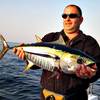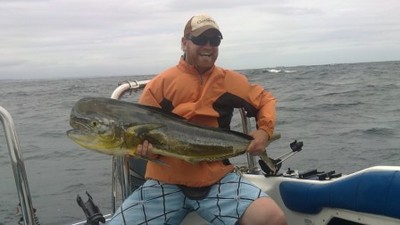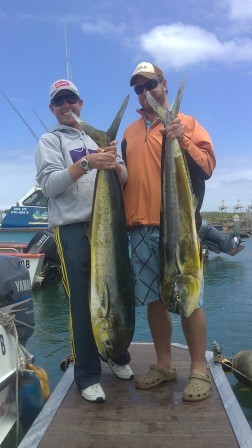Dorado - Also known as Mahi-mahi and Dolphin fish.
Dorado is one of the most fun fish to catch in our oceans, their greedy gregarious feeding habits along with the aerial acrobatics when hooked up make this species a firm favourite amongst offshore anglers, not to mention the fact that they also make good table fair.
Dorado is Spanish for "golden" and it reminds one of El Dorado "The lost city of Gold" which I am sure is due to the conspicuous colouring of this species. Dorado is also a constellation in the Southern Sky that has a Large Magellanic Cloud surrounding it.
The name Mahi-mahi comes from Hawaii which means "very strong" and I am quite certain that this derives from the fight these fish give when hooked up.
Dorado are surface dwellers and are found offshore in temperate, tropical and subtropical waters all over the world, they are an extremely fast growing species with an average lifespan of around 5yrs, average sizes caught are from 6-15Kgs, they can get larger with some fish reaching well over 20Kgs which are usually Bulls and are highly sought after by Sport anglers worldwide. These fish often swim in small shoals when younger, and the mature ones are usually found in pairs, so you can be sure if you catch a male the female is right there close by.
Dorado will usually be around when water temperatures reach 24deg.C and higher, known as an open water species it is common that they are caught out in the deeper waters, but these fish can also often be found near shallow reefs and even right behind the breakers.
You will often find them hunting near shallow pinnacles and ledges, colour lines, current lines, weed lines and one of my personal favorite places is by floating debris. Off Durban you will also find them at the FADS. When you go out looking for Dorado you need to find these types of places and you will most likely find Dorado.
They are not a difficult fish to hook up as they are ravenous greedy predators that will eat just about anything that moves from small to large, fast moving and slow moving, they like bright colours and shiny things and so just about any lure will do the trick.
Lures
There are many lures that can be used, and I have caught them on small spoons meant for Queen Mackerel right through to large 12 inch Kona's meant for Marlin so there is no saying which lure is perfect for them, I will list some of my favorites which have produced me many Dorado over the years.
Lipped Lures My personal favorites are the shallow runners
Halco Laser Pros in the 160 size
Rapala X-Rap Splash Baits in size 14
Colours that I prefer are Pink, Red heads and Blue Silver.
These can be trolled from 4 knots right through to around 9 knots.
Feathers I love using feathers for Dorado
Tuna Feathers work extremely well, just change the Tuna hook to a single
Jet Feathers, specifically the Williamson ones
Small flash feathers
Colours that I prefer Blue/White, Red/White, Black/Purple, Green/Yellow, Red/Black
These can be trolled from 6 knots right through to around 12 knots.
Kona's from 6 inch right through to 9 inch, with 8 inch being my favourite
Cup Faced Kona's work like a charm off the riggers
Slanted faced Kona's are best off the corners, and don't be scared to come in close, even as close as 5 meters
When trolling Kona's I like to stick a large one far back on the shot gun, typically I like to use a mould craft wide range here.
Colours that I prefer Orange/Yellow, Black/Purple, Blue/Pink, Blue/White, Red/Black
These can be trolled from 6 knots right through to around 12 knots.
Lures like the Island lures are ideal for adding strip baits, and 6 inch cupped faced lures like the Williamson Sailfish Catcher are perfect for adding whole dead baits into your trolling spread.
Once you have a hook up and you are fighting the fish, do not clear all your lines and never ever stop the boat, keep it at least one motor engaged. I usually like to keep one of the rigger lines and the shot gun out as far too many times you will get the mate screaming off with one of these whilst you are fighting the initial hook up. Keep a spinning rod handy for pitch baits and once you get your first fish close to the boat hold him there about 10m away, rig up a dead sardine on the spinning rod and cast it out and let this drift because if it was a shoal all the other Dorado's will be following that fish, only once this baited line goes on with a fish do you bring in the initial fish, and you repeat this procedure until there is no more action, often you can get another 5 or 6 Dorado once you have the initial hook up, but almost always you will at least catch the mate.
Dead Baits and Live Baits
Dorado loooove dead sardines and mackerel, these can be fished in several ways, as mentioned above you can use sardines to add some flavor to you Kona's, and you can also troll them slowly behind the boat, especially when you find floating debris, weed lines and so on. You can also fish these dead baits or live Mackerel on the drift using balloons (keeping baits close to the surface), where you keep close to a weed line or near the debris, if the current is screaming there is no need to use balloons as the speed alone will keep your baits up. Drifting dead sardines and live mackerel like this works extremely well when the North East wind is blowing. You can also use spinning rods and cast these dead sardines at the weed lines or debris whilst on the drift. For drifting dead baits I like to use a leader of 0.8mm 1.0mm and a narrow gauge J hook from 6/0 to 8/0 which you simply push through the eye sockets, and a 7/0 circle hook also works extremely well.
Again, once you have the 1st fish on, do not boat him until you get the second hook up.
This method makes your boat into a FAD (Fish Aggregating Device) all by itself and you will often find the Dorado feeding right at the boat. Often using this method we have had 5 or even 6 fish on at the same time.
Handling Dorado
To have a clear conscience after writing this article, I have to include a little about handling these fish. Dorado are bad tempered fish, and when hooked up fight like mad and jump like crazy, once on board they go even crazier and if not dealt with correctly can cause injury to those on the boat, especially when chain gangs are involved.
The best thing to do is before you gaff the fish, have a crew member open the fish hatch so when you gaff the fish, you gaff and bring over board directly into the fish hatch in one move and shut the door.




